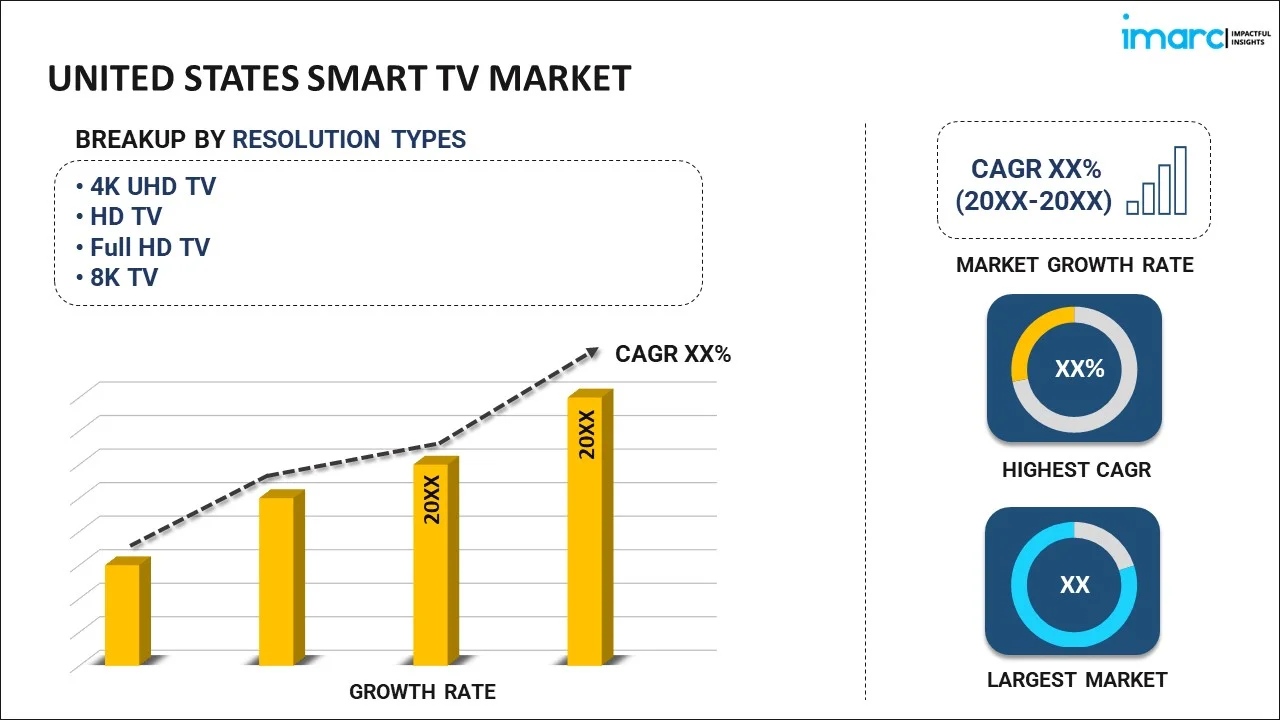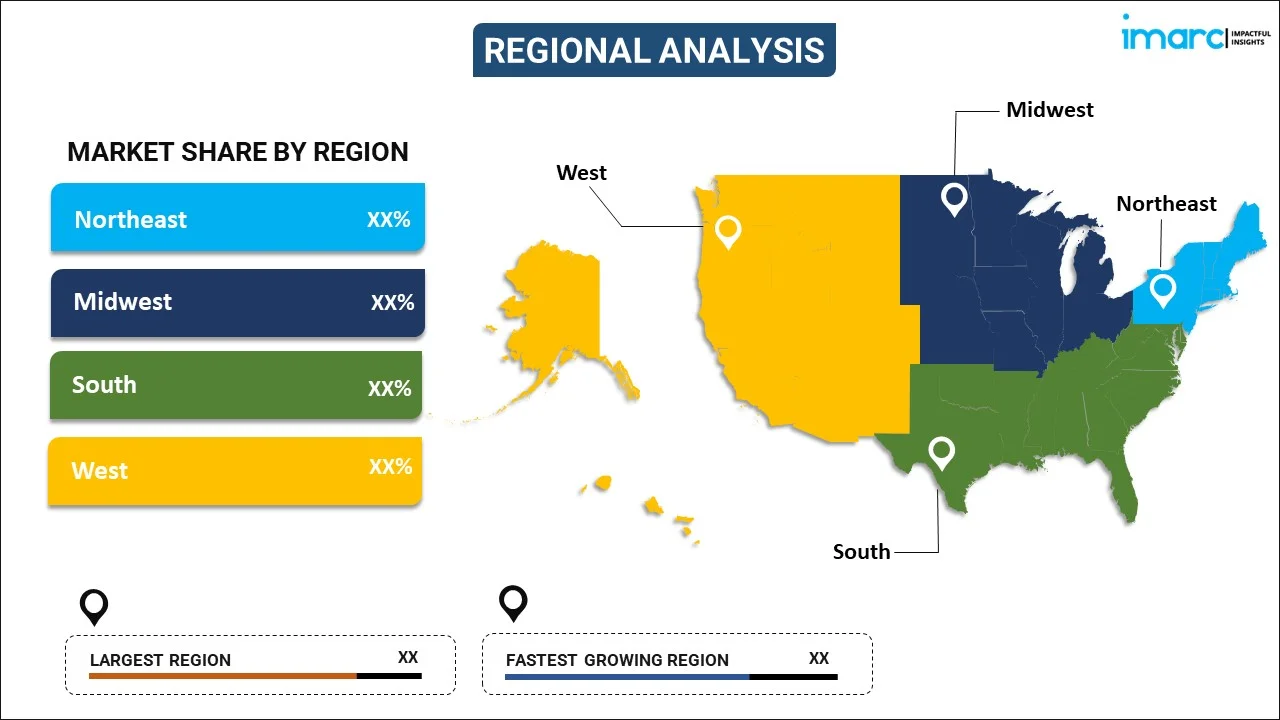
United States Smart TV Market Report by Resolution Type (4K UHD TV, HD TV, Full HD TV, 8K TV), Screen Size (Below 32 Inches, 32 to 45 Inches, 46 to 55 Inches, 56 to 65 Inches, Above 65 Inches), Screen Type (Flat, Curved), Technology (Liquid Crystal Display (LCD), Light Emitting Diode (LED), Organic Light Emitting Diode (OLED), Quantum Dot Light Emitting Diode (QLED), Platform (Android, Roku, WebOS, Tizen OS, iOS, MyHomeScreen, and Others), Distribution Channel (Offline, Online), Application (Residential, Commercial), and Region 2025-2033
Market Overview:
The United States smart TV market size reached USD 71,740.6 Million in 2024. Looking forward, IMARC Group expects the market to reach USD 85,133.4 Million by 2033, exhibiting a growth rate (CAGR) of 1.90% during 2025-2033. The growing popularity of streaming services, the widespread adoption of smart TV in the educational sector, and the continuous evolution of technology led manufacturers to innovate, improve screen quality, enhance connectivity options, and incorporate voice recognition features into their products represent some of the key factors driving the market.
|
Report Attribute
|
Key Statistics
|
|---|---|
|
Base Year
|
2024
|
|
Forecast Years
|
2025-2033
|
|
Historical Years
|
2019-2024
|
|
Market Size in 2024
|
USD 71,740.6 Million |
|
Market Forecast in 2033
|
USD 85,133.4 Million |
| Market Growth Rate 2025-2033 | 1.90% |
A smart TV, or smart television, is a modern television that integrates advanced technology to offer several interactive and internet-connected features. They are equipped with built-in processors, internet connectivity, and various applications, making them more versatile and capable of providing a more interactive and personalized viewing experience. It can connect to the internet through either a wired Ethernet connection or Wi-Fi, which opens up several possibilities, allowing users to stream content from popular online platforms such as Netflix, Amazon Prime Video, Hulu, YouTube, and many others. They allow users to access a vast library of movies, TV shows, documentaries, and live TV channels through various streaming services. They are also available with app stores where users can download and install applications tailored for the television screen which can range from social media platforms, news apps, gaming apps, and even specialized apps for fitness or cooking enthusiasts. Additionally, smart TVs include voice recognition technology, enabling users to control the TV and search for content using voice commands, which enhances user convenience and accessibility. They can also be integrated into a smart home ecosystem, allowing users to control other compatible devices, such as smart lights, thermostats, and security cameras, through the television's interface.
United States Smart TV Market Trends:
The market is primarily driven by the growing popularity of streaming services. In addition, the proliferation of streaming services such as Netflix, Amazon Prime Video, Disney+, and Hulu led to the widespread adoption of smart TVs, thus contributing to the market growth. These platforms offer a vast library of content, while consumers are looking for large screens with smart capabilities to enjoy their favorite shows and movies. Moreover, the continuous evolution of technology led several manufacturers to constantly innovate, improve screen quality, enhance connectivity options, and incorporate voice recognition and artificial intelligence features into their products, representing another major growth-inducing factor. These advancements make smart TVs more appealing to consumers. Besides this, smart TVs are often part of tech giants such as Apple, Google, and Amazon, which allow seamless connectivity between various devices, such as smartphones, tablets, and smart speakers, creating a more integrated and convenient user experience. Along with this, the rising consumer demand for advanced entertainment solutions such as smart TVs, which offer a seamless integration of traditional television with internet-based content streaming, provides viewers with several options in terms of content and convenience, thus propelling the market growth. Apart from this, the increasing use of smart TVs for educational and productivity features and the integration of apps for online learning and work-related tasks for students and professionals thus created a positive market outlook.
United States Smart TV Market Segmentation:
IMARC Group provides an analysis of the key trends in each segment of the market, along with forecasts at the country level for 2025-2033. Our report has categorized the market based on resolution type, screen size, screen type, technology, platform, distribution channel, and application.
Resolution Type Insights:

- 4K UHD TV
- HD TV
- Full HD TV
- 8K TV
The report has provided a detailed breakup and analysis of the market based on the resolution type. This includes 4K UHD TV, HD TV, full HD TV, and 8K TV.
Screen Size Insights:
- Below 32 Inches
- 32 to 45 Inches
- 46 to 55 Inches
- 56 to 65 Inches
- Above 65 Inches
A detailed breakup and analysis of the market based on the screen size have also been provided in the report. This includes below 32 inches, 32 to 45 inches, 46 to 55 inches, 56 to 65 inches, and above 65 inches.
Screen Type Insights:
- Flat
- Curved
The report has provided a detailed breakup and analysis of the market based on the screen type. This includes flat and curved.
Technology Insights:
- Liquid Crystal Display (LCD)
- Light Emitting Diode (LED)
- Organic Light Emitting Diode (OLED)
- Quantum Dot Light Emitting Diode (QLED)
A detailed breakup and analysis of the market based on the technology have also been provided in the report. This includes liquid crystal display (LCD), light emitting diode (LED), organic light emitting diode (OLED), and quantum dot light emitting diode (QLED).
Platform Insights:
- Android
- Roku
- WebOS
- Tizen OS
- iOS
- MyHomeScreen
- Others
The report has provided a detailed breakup and analysis of the market based on the platform. This includes android, roku, webOS, tizen OS, iOS, myhomescreen, and others.
Distribution Channel Insights:
- Offline
- Online
A detailed breakup and analysis of the market based on the distribution channel have also been provided in the report. This includes offline and online.
Application Insights:
- Residential
- Commercial
The report has provided a detailed breakup and analysis of the market based on the application. This includes residential and commercial.
Regional Insights:

- Northeast
- Midwest
- South
- West
The report has also provided a comprehensive analysis of all the major regional markets, which include Northeast, Midwest, South, and West.
Competitive Landscape:
The market research report has also provided a comprehensive analysis of the competitive landscape. Competitive analysis such as market structure, key player positioning, top winning strategies, competitive dashboard, and company evaluation quadrant has been covered in the report. Also, detailed profiles of all major companies have been provided. Some of the key players include:
- Koninklijke Philips N.V.
- LG Electronics Inc.
- Samsung Electronics Co. Ltd
- Sharp Electronics Corporation
- Sony Electronics Inc.
(Please note that this is only a partial list of the key players, and the complete list is provided in the report.)
United States Smart TV Market Report Coverage:
| Report Features | Details |
|---|---|
| Base Year of the Analysis | 2024 |
| Historical Period | 2019-2024 |
| Forecast Period | 2025-2033 |
| Units | Million USD |
| Scope of the Report |
Exploration of Historical and Forecast Trends, Industry Catalysts and Challenges, Segment-Wise Historical and Predictive Market Assessment:
|
| Resolution Types Covered | 4K UHD TV, HD TV, Full HD TV, 8K TV |
| Screen Sizes Covered | Below 32 Inches, 32 to 45 Inches, 46 to 55 Inches, 56 to 65 Inches, Above 65 Inches |
| Screen Types Covered | Flat, Curved |
| Technologies Covered | Liquid Crystal Display (LCD), Light Emitting Diode (LED), Organic Light Emitting Diode (OLED), Quantum Dot Light Emitting Diode (QLED) |
| Platforms Covered | Android, Roku, WebOS, Tizen OS, iOS, MyHomeScreen, Others |
| Distribution Channels Covered | Offline, Online |
| Applications Covered | Residential, Commercial |
| Regions Covered | Northeast, Midwest, South, West |
| Companies Covered | Koninklijke Philips N.V., LG Electronics Inc., Samsung Electronics Co. Ltd, Sharp Electronics Corporation, Sony Electronics Inc., etc. |
| Customization Scope | 10% Free Customization |
| Post-Sale Analyst Support | 10-12 Weeks |
| Delivery Format | PDF and Excel through Email (We can also provide the editable version of the report in PPT/Word format on special request) |
Key Questions Answered in This Report:
- How has the United States smart TV market performed so far and how will it perform in the coming years?
- What has been the impact of COVID-19 on the United States smart TV market?
- What is the breakup of the United States smart TV market on the basis of resolution type?
- What is the breakup of the United States smart TV market on the basis of screen size?
- What is the breakup of the United States smart TV market on the basis of screen type?
- What is the breakup of the United States smart TV market on the basis of technology?
- What is the breakup of the United States smart TV market on the basis of platform?
- What is the breakup of the United States smart TV market on the basis of distribution channel?
- What is the breakup of the United States smart TV market on the basis of application?
- What are the various stages in the value chain of the United States smart TV market?
- What are the key driving factors and challenges in the United States smart TV?
- What is the structure of the United States smart TV market and who are the key players?
- What is the degree of competition in the United States smart TV market?
Key Benefits for Stakeholders:
- IMARC’s industry report offers a comprehensive quantitative analysis of various market segments, historical and current market trends, market forecasts, and dynamics of the United States smart TV market from 2019-2033.
- The research report provides the latest information on the market drivers, challenges, and opportunities in the United States smart TV market.
- Porter's five forces analysis assist stakeholders in assessing the impact of new entrants, competitive rivalry, supplier power, buyer power, and the threat of substitution. It helps stakeholders to analyze the level of competition within the United States smart TV industry and its attractiveness.
- Competitive landscape allows stakeholders to understand their competitive environment and provides an insight into the current positions of key players in the market.
Need more help?
- Speak to our experienced analysts for insights on the current market scenarios.
- Include additional segments and countries to customize the report as per your requirement.
- Gain an unparalleled competitive advantage in your domain by understanding how to utilize the report and positively impacting your operations and revenue.
- For further assistance, please connect with our analysts.
 Inquire Before Buying
Inquire Before Buying
 Speak to an Analyst
Speak to an Analyst
 Request Brochure
Request Brochure
 Request Customization
Request Customization




.webp)




.webp)












